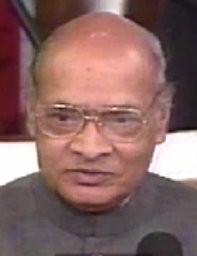PV Narasimha Rao
| P. V. Narasimha Rao | |
|---|---|

P. V. Narasimha Rao
|
|
| 9th Prime Minister of India | |
|
In office 21 June 1991 – 16 May 1996 |
|
| President |
R. Venkataraman Shankar Dayal Sharma |
| Preceded by | Chandra Shekhar |
| Succeeded by | Atal Bihari Vajpayee |
| Minister of Defence | |
|
In office 6 March 1993 – 16 May 1996 |
|
| Preceded by | Shankarrao Chavan |
| Succeeded by | Pramod Mahajan |
|
In office 31 December 1984 – 25 September 1985 |
|
| Prime Minister | Rajiv Gandhi |
| Preceded by | Rajiv Gandhi |
| Succeeded by | Shankarrao Chavan |
| Minister of External Affairs | |
|
In office 31 March 1992 – 18 January 1993 |
|
| Preceded by | Madhavsinh Solanki |
| Succeeded by | Dinesh Singh |
|
In office 25 June 1988 – 2 December 1989 |
|
| Prime Minister | Rajiv Gandhi |
| Preceded by | Rajiv Gandhi |
| Succeeded by | V. P. Singh |
|
In office 14 January 1980 – 19 July 1984 |
|
| Prime Minister | Indira Gandhi |
| Preceded by | Shyam Nandan Prasad Mishra |
| Succeeded by | Indira Gandhi |
| Minister of Home Affairs | |
|
In office 12 March 1986 – 12 May 1986 |
|
| Prime Minister | Rajiv Gandhi |
| Preceded by | Shankarrao Chavan |
| Succeeded by | Sardar Buta Singh |
|
In office 19 July 1984 – 31 December 1984 |
|
| Prime Minister |
Indira Gandhi Rajiv Gandhi |
| Preceded by | Prakash Chandra Sethi |
| Succeeded by | Shankarrao Chavan |
| Chief Minister of Andhra Pradesh | |
|
In office 30 September 1971 – 10 January 1973 |
|
| Governor | Khandubhai Kasanji Desai |
| Preceded by | Kasu Brahmananda Reddy |
| Succeeded by | Jalagam Vengala Rao (after President's Rule) |
| Personal details | |
| Born |
28 June 1921 Laknepally, Warangal district,Hyderabad State, British India (now in Telangana), India |
| Died | 23 December 2004 (aged 83) New Delhi, India |
| Cause of death | Heart attack |
| Political party | Indian National Congress |
| Spouse(s) | Satyamma (d. 1970) |
| Alma mater |
Osmania University University of Mumbai Nagpur University |
| Occupation |
|
Pamulaparti Venkata Narasimha Rao (28 June 1921 – 23 December 2004) was an Indian lawyer and politician who served as the 9th Prime Minister of India, from 1991–1996. His ascendancy to the prime ministership was politically significant in that he was the first holder of this office from a non-Hindi-speaking region, belonging to the southern part of India. He led an important administration, overseeing a major economic transformation and several home incidents affecting national security of India. Rao, who held the Industries portfolio, was personally responsible for the dismantling of the Licence Raj, as this came under the purview of the Ministry of Commerce and Industry. He is often referred to as the "Father of Indian Economic Reforms". Future prime ministers Atal Bihari Vajpayee and Manmohan Singh continued the economic reform policies pioneered by Rao's government. Rao accelerated the dismantling of the License Raj, reversing the socialist policies of Rajiv Gandhi's government. He employed Dr. Manmohan Singh as his Finance Minister to embark on historic economic transition. With Rao's mandate, Dr. Manmohan Singh launched India's globalisation angle of the reforms that implemented the International Monetary Fund (IMF) policies to rescue the almost bankrupt nation from economic collapse. Rao was also referred to as Chanakya for his ability to steer tough economic and political legislation through the parliament at a time when he headed a minority government.
...
Wikipedia
